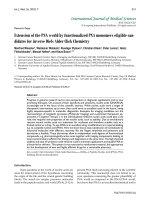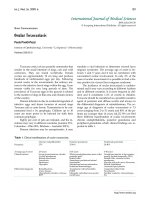Báo cáo y học: "Institute of Ophthalmology, University “La Sapienza” of Rome (Italy"
Bạn đang xem bản rút gọn của tài liệu. Xem và tải ngay bản đầy đủ của tài liệu tại đây (111.83 KB, 2 trang )
Int. J. Med. Sci. 2009, 6
131
I
I
n
n
t
t
e
e
r
r
n
n
a
a
t
t
i
i
o
o
n
n
a
a
l
l
J
J
o
o
u
u
r
r
n
n
a
a
l
l
o
o
f
f
M
M
e
e
d
d
i
i
c
c
a
a
l
l
S
S
c
c
i
i
e
e
n
n
c
c
e
e
s
s
2009; 6(3):131-132
© Ivyspring International Publisher. All rights reserved
Short Communication
Ocular Bartonellosis
Massimo Accorinti
Institute of Ophthalmology, University “La Sapienza” of Rome (Italy)
Published: 2009.03.19
Bartonella henselae is a gram negative aerobic
bacillus and is the etiologic agent of cat-scratch dis-
ease. The infection is present around the world and
may affect patients of all ages, including immuno-
competent individuals. Humans are usually infected
through a cat’s scratch or bite, but a bite by cat fleas
may also be the origin of infection. More common in
children and young adults, it usually presents with a
wide range of systemic and ocular symptoms. Other
Bartonella species have been described as causing
ocular lesions, as shown in Table 1.
Systemic signs and symptoms usually precede
ocular involvement and are constituted by the ap-
pearance, 3 to 10 days after inoculation of bartonella
by scratch or bite, of an erythematous papule on the
skin on the site of inoculation. Seven to 14 days after
the exposure a follicular conjunctivitis may appear.
Fourteen to 21 days after the inoculation regional
lymphoadenopathy may occur which is usually asso-
ciated with myalgias, fatigue and low-grade fever.
The association of conjunctivits and regional lym-
phoadenopathy is well known as Parinaud’s oculo-
glandular syndrome (POGS).
Ocular signs
The most frequent ocular manifestation is neu-
roretinitis which is usually unilateral. If neuroretinitis
is bilateral, it is quite asymmetric. Rarely, posterior
pole involvement may be characterized by the pres-
ence of a focal inflammatory mass, either of the retina
or of the optic disk. Central or paracentral scotoma or
physiologic blind spot enlargement are the main al-
terations of the visual field, while fluorescein an-
giography usually presents a diffuse leakage from the
optic nerve head along with the retinal vessels. Some-
times vascular occlusion with intraretinal haemor-
rhages and cotton-wool spots are present at the pos-
terior pole. Anterior uveitis, intermediate uveitis and
orbital abscess may also be observed in bartonellosis.
In HIV-seropositive patients, some cases of bacillary
angiomatosis and subretinal neovascular granuloma
have been reported.
Diagnosis and Differential diagnosis
Enzyme immunoassay and Western Blot, along
with PCR analysis, are usually used for diagnosis,
although past history of contact with cats should lead
to suspect the proper diagnosis. Serologic tests show a
specificity and sensitivity of 90% in immunocompe-
tent patients and only 70% in immunodeficient sub-
jects.
Parinaud’s syndrome is a clinical entity that may
be due to numerous infections, including tularaemia,
sporotrichosis, tuberculosis, syphilis, mononucleosis,
coccidioidomycosis, while neuroretinitis with macu-
lar star may be observed in vascular disorders,
toxoplasmosis, syphilis, tuberculosis, Lyme disease,
and viral infection.
Table 1. Bartonella species pathogens for the eye
Bartonella
Species
Reservoir
Host
Acute Bac-
teremic
Syndromes
Ocular Syn-
dromes
Chronic
Vascular
Lesions
Henselae Cats Relapsing
fever, en-
docarditis
POGS,
neuroretinitis,
retinochoroiditis,
vascular
occlusion,
intermediate
vasculitis
Bacillary
angioma
tosis
Quintana Human Trench fe-
ver, endo-
carditis
Neuroretinis,
POGS
Bacillary
angioma
tosis
Elizabethae Rodent Endocarditis Neuroretinis
Grahamii Rodent Neuroretinis
Int. J. Med. Sci. 2009, 6
132
Treatment
Cat scratch disease is usually a self-limited dis-
ease in immunocompetent patients. Bartonella
henselae is sensitive to many antibiotics in vitro, but
only aminoglycosides have bactericidal activity. In
immunocompetent patients doxycicline 200 mg/day
is usually administered because of its property to
cross the blood-brain and blood-ocular barrier. Cau-
tion should be made if administered to children, be-
cause it may cause dental changes. Ciprofloxacin (1,5
gr/day), gentamicin (3-5 mg/kg/day), erythromycin
(2 gr/day), trimethoprim-sulphamethoxazole (Bac-
trim ® 2 tablets/day) are good alternatives and, like
doxycicline, are usually given for 14 to 28 days.
Azythromicin may also be given to patients affected
by cat scratch disease at 500 mg/day for 3 to 5 days.
Immunodeficient patients need a more prolonged
course of treatment, usually up to 4 months.
Ocular lesions are treated with antibiotics and
with topical steroids for conjunctival lesion, topical
steroids and mydriatics for anterior segment in-
volvement and with peribulbar (sub-tenon) steroid
injection and/or systemic steroids for retinal and op-
tic nerve involvement. In this last case it is important
to start steroid therapy after at least 48 hours from
starting specific antibiotic treatment, especially if
given locally in a depot preparation.







